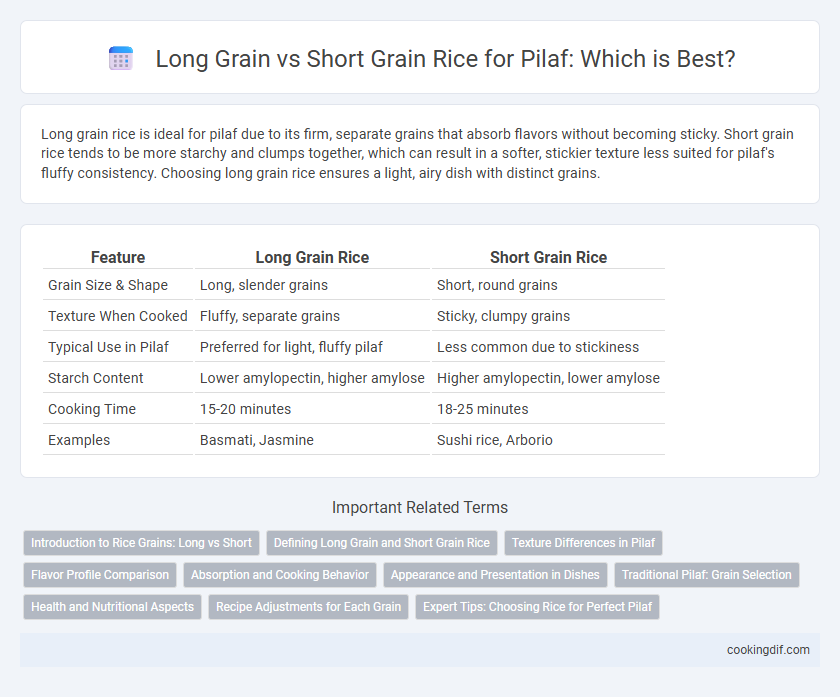Long grain rice is ideal for pilaf due to its firm, separate grains that absorb flavors without becoming sticky. Short grain rice tends to be more starchy and clumps together, which can result in a softer, stickier texture less suited for pilaf's fluffy consistency. Choosing long grain rice ensures a light, airy dish with distinct grains.
Table of Comparison
| Feature | Long Grain Rice | Short Grain Rice |
|---|---|---|
| Grain Size & Shape | Long, slender grains | Short, round grains |
| Texture When Cooked | Fluffy, separate grains | Sticky, clumpy grains |
| Typical Use in Pilaf | Preferred for light, fluffy pilaf | Less common due to stickiness |
| Starch Content | Lower amylopectin, higher amylose | Higher amylopectin, lower amylose |
| Cooking Time | 15-20 minutes | 18-25 minutes |
| Examples | Basmati, Jasmine | Sushi rice, Arborio |
Introduction to Rice Grains: Long vs Short
Long grain rice varieties such as Basmati and Jasmine have slender, elongated kernels that remain separate and fluffy when cooked, making them ideal for pilaf dishes. Short grain rice, including Arborio and sushi rice, features rounder, plumper grains that tend to clump together and produce a creamier texture, which may alter the pilaf's traditional fluffy consistency. Understanding these grain characteristics helps in selecting the appropriate rice type to achieve the desired pilaf texture and flavor.
Defining Long Grain and Short Grain Rice
Long grain rice features slender, elongated kernels that remain separate and fluffy when cooked, making it ideal for pilaf where distinct grains are preferred. Short grain rice has plump, almost round kernels that tend to stick together, producing a creamier texture often reserved for risotto or sushi rather than pilaf. Understanding the physical differences helps select the right rice type to achieve the desired pilaf texture and presentation.
Texture Differences in Pilaf
Long grain rice, such as Basmati or Jasmine, produces a fluffy and separate texture in pilaf, with individual grains that remain distinct and less sticky. Short grain rice tends to create a softer, creamier texture due to its higher starch content, causing the grains to clump together more easily. The choice between long grain and short grain significantly impacts the pilaf's final mouthfeel and presentation, with long grain preferred for light, airy dishes and short grain for richer, more cohesive textures.
Flavor Profile Comparison
Long grain rice offers a light, fluffy texture with a mildly nutty flavor ideal for pilaf, allowing individual grains to remain separate. Short grain rice features a plumper, stickier texture with a slightly sweet, creamy taste that creates a more cohesive dish. The choice between long and short grain rice significantly impacts pilaf's mouthfeel and flavor intensity.
Absorption and Cooking Behavior
Long grain rice exhibits lower starch content, resulting in better absorption of broth and separate, fluffy grains ideal for pilaf dishes. Short grain rice has higher amylopectin levels, causing stickiness and clumping, which leads to a creamier texture but less distinct grains. Choosing long grain rice enhances pilaf's characteristic light texture through efficient liquid absorption and minimal grain adhesion.
Appearance and Presentation in Dishes
Long grain rice displays a slender, elongated shape that remains separate and fluffy after cooking, creating a visually appealing and elegant pilaf presentation. Short grain rice cooks up plumper and stickier, resulting in a creamier, more cohesive pilaf with a moister texture that enhances solidarity in the dish's appearance. Choosing long grain for pilaf ensures distinct grains and a light texture, while short grain offers a denser, more uniform look suitable for presentations requiring a rich, compact presentation.
Traditional Pilaf: Grain Selection
Traditional pilaf typically favors long grain rice varieties such as Basmati or Jasmine due to their elongated shape and fluffy texture, which prevent clumping during cooking. Short grain rice tends to be stickier and more moist, making it less ideal for pilaf where separate, individual grains are preferred. Selecting high-quality, aged long grain rice enhances the pilaf's aromatic qualities and ensures a perfect al dente finish.
Health and Nutritional Aspects
Long grain rice varieties, such as basmati and jasmine, have a lower glycemic index compared to short grain rice, which can aid in better blood sugar control and sustained energy levels. Short grain rice typically contains higher amylopectin, contributing to its sticky texture, but may result in quicker glucose absorption, impacting insulin response. Both types provide essential nutrients like manganese and selenium, yet long grain pilaf often offers a lighter, less calorie-dense option ideal for weight management and balanced diets.
Recipe Adjustments for Each Grain
Long grain rice requires less water and a longer simmer time to ensure fluffy, separate grains ideal for pilaf, while short grain rice absorbs more water and benefits from a shorter cooking duration to prevent mushiness. Adjust the liquid ratio to roughly 1.5 cups of water per cup of long grain rice and up to 1.75 cups for short grain to achieve optimal texture. Stir gently during cooking with short grain varieties to maintain a creamy consistency without breaking the grains, unlike with long grain rice which is better left undisturbed.
Expert Tips: Choosing Rice for Perfect Pilaf
For perfect pilaf, long grain rice is ideal due to its lower starch content, which prevents clumping and ensures fluffy, separate grains. Short grain rice tends to be stickier, absorbing more liquid and making the pilaf denser, often resulting in a creamier texture unsuitable for traditional pilaf dishes. Experts recommend rinsing long grain rice thoroughly to remove surface starch and using a precise water-to-rice ratio for optimal texture and flavor absorption.
Long grain vs Short grain for pilaf Infographic

 cookingdif.com
cookingdif.com